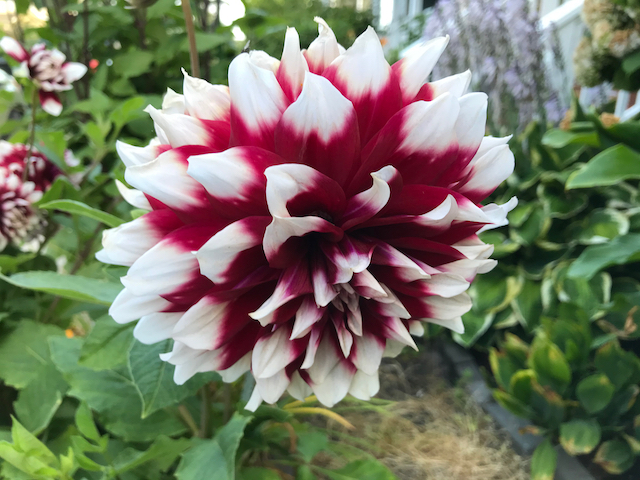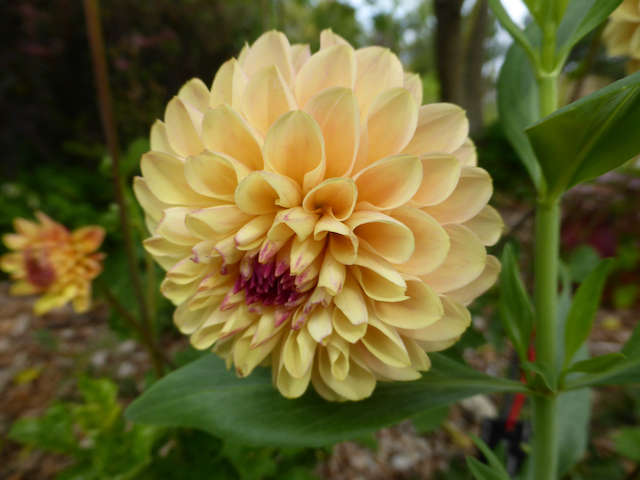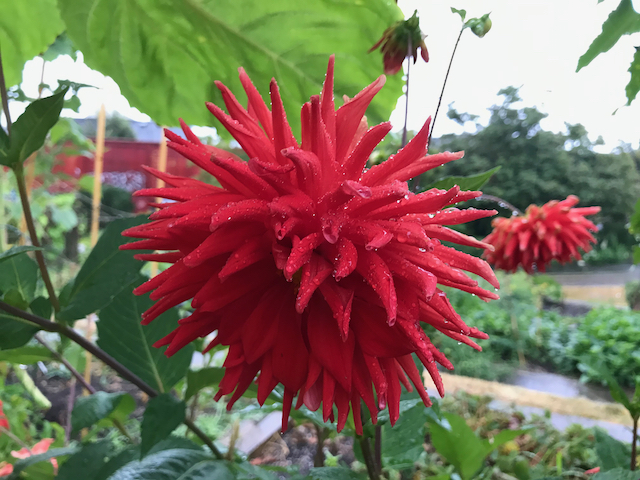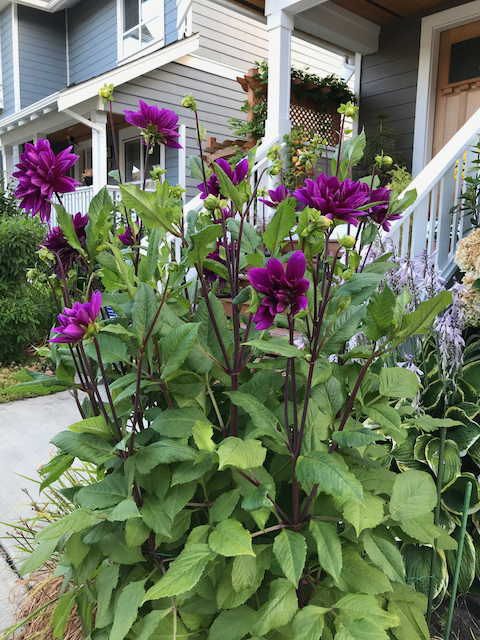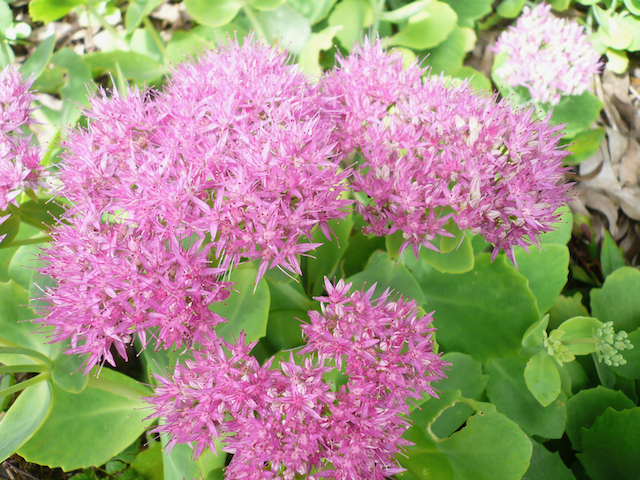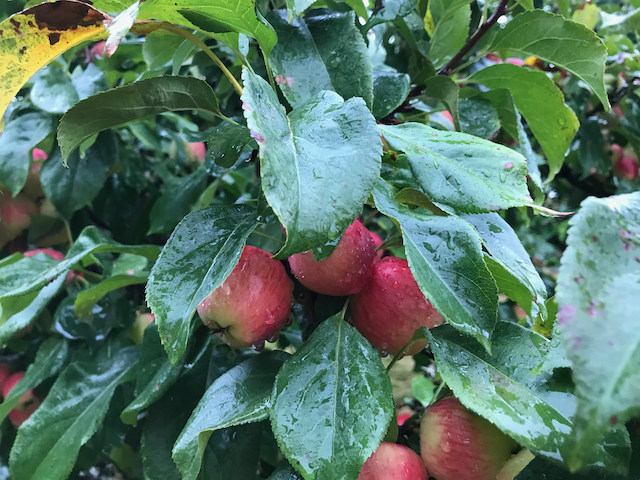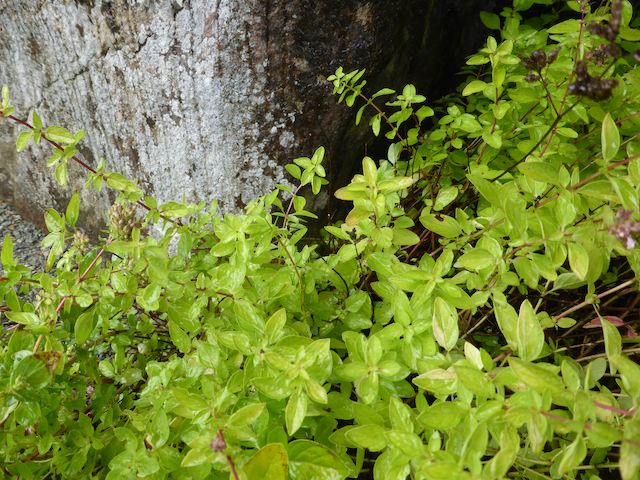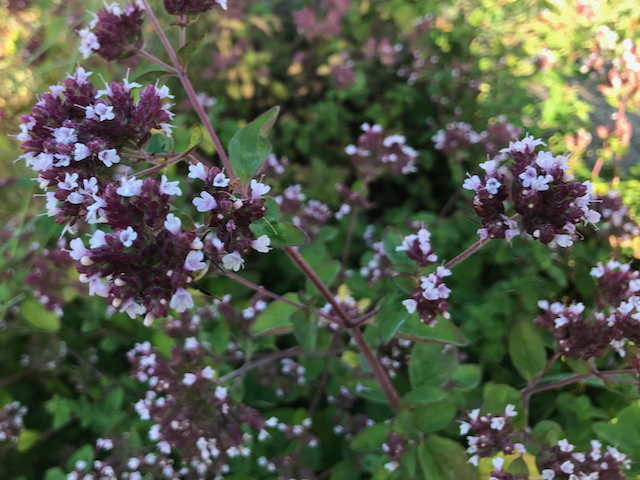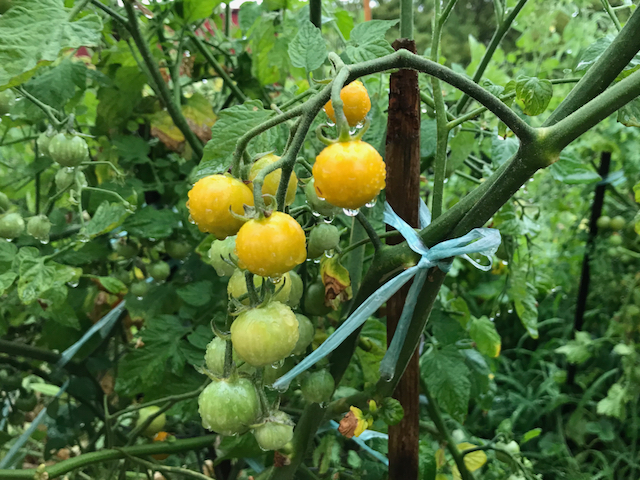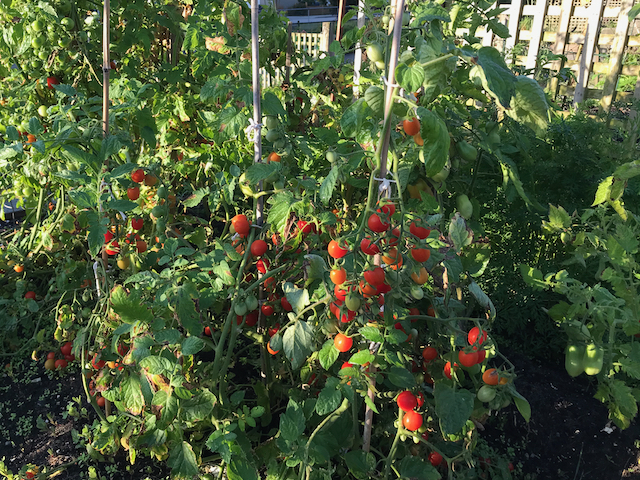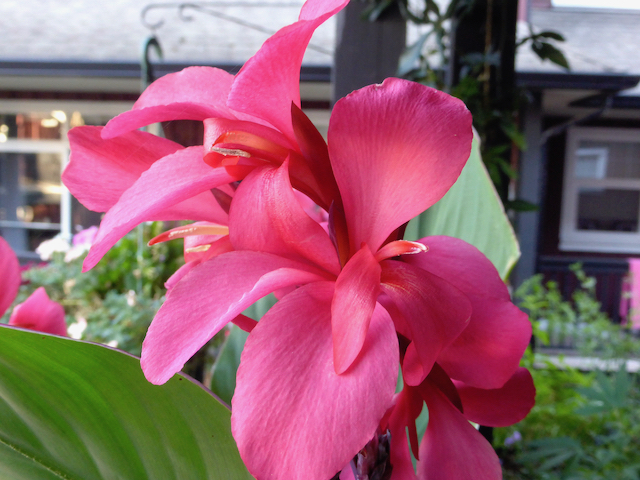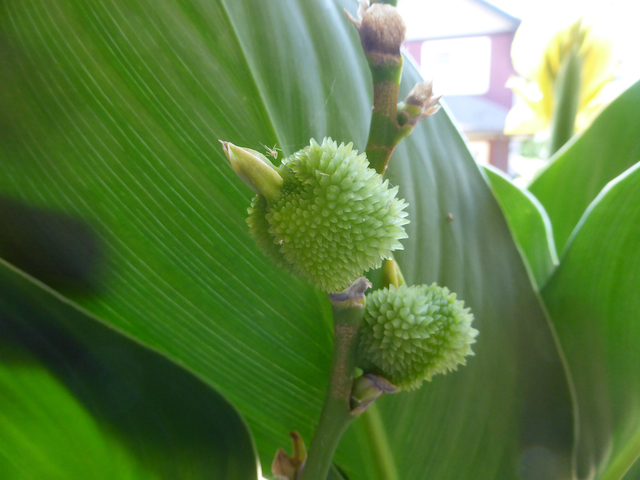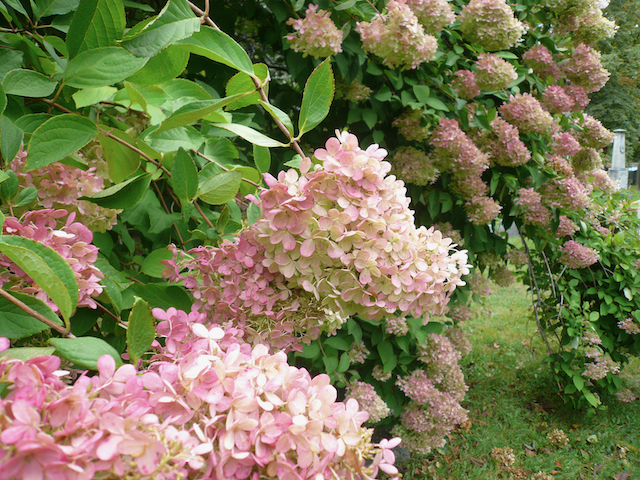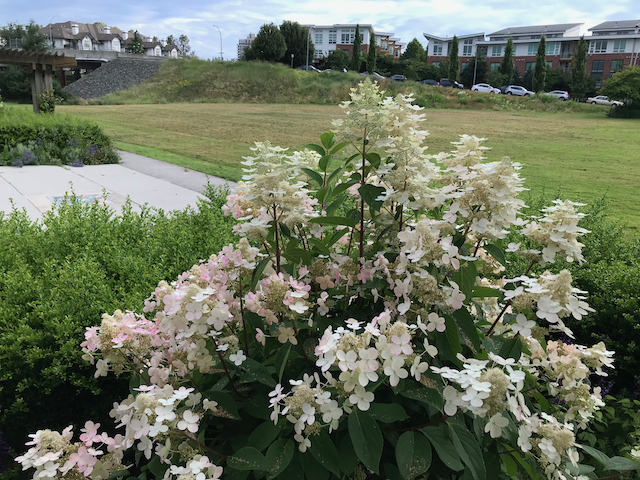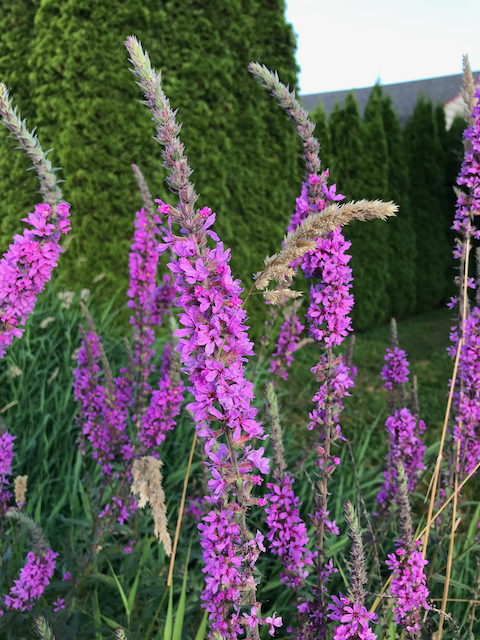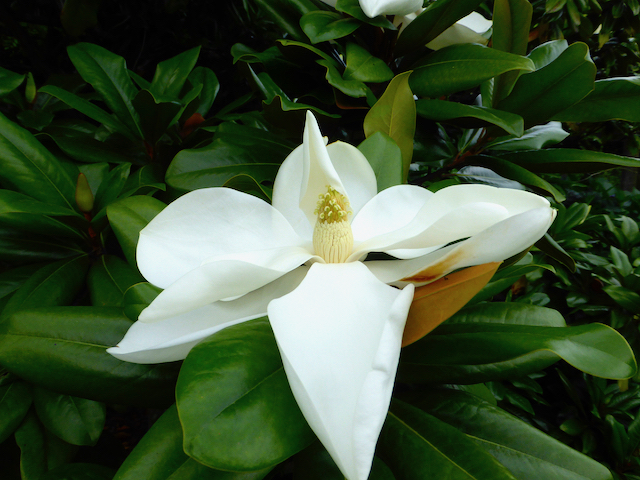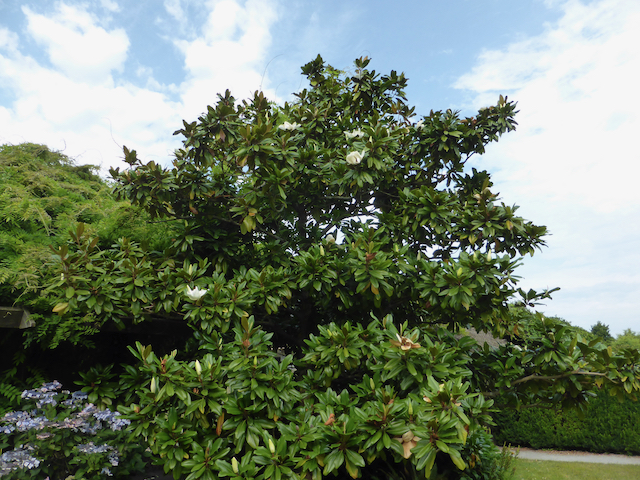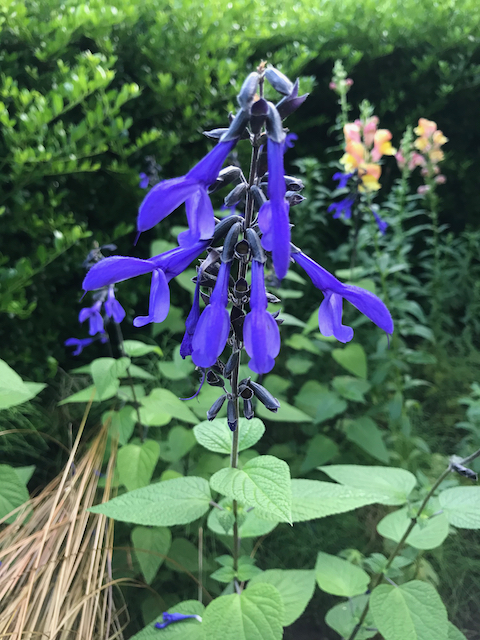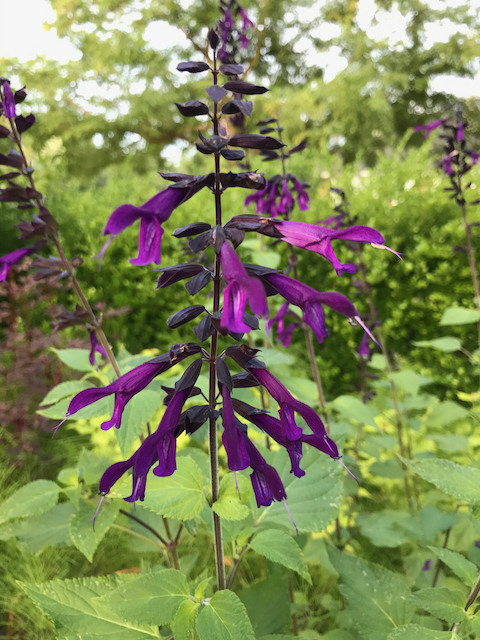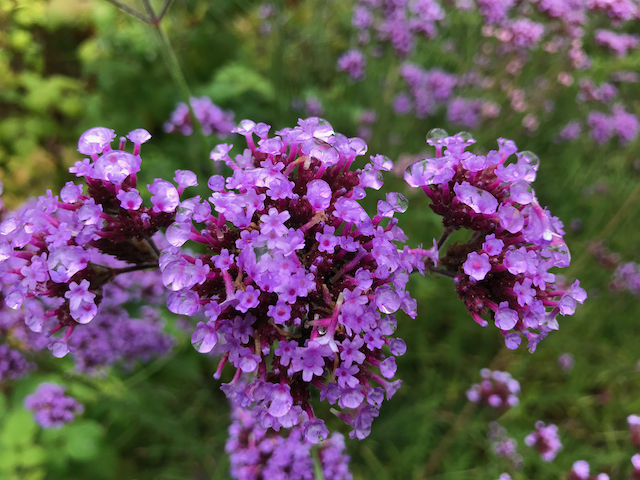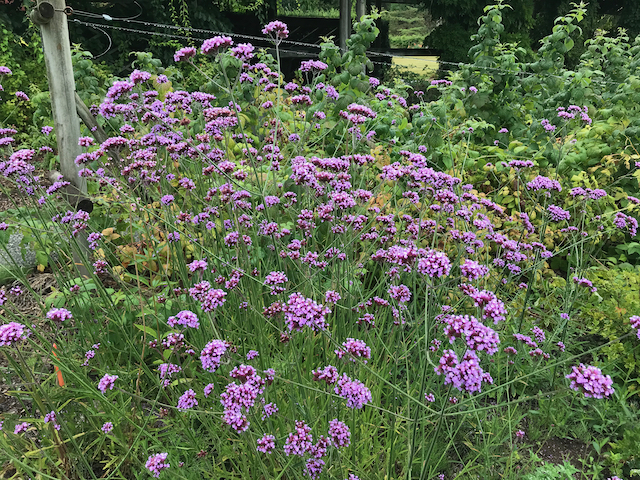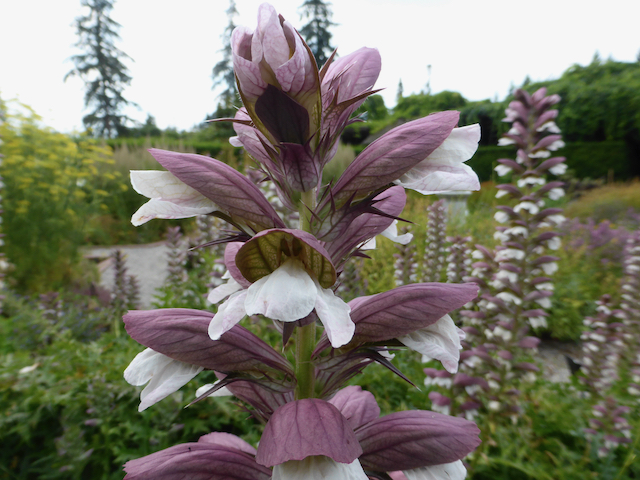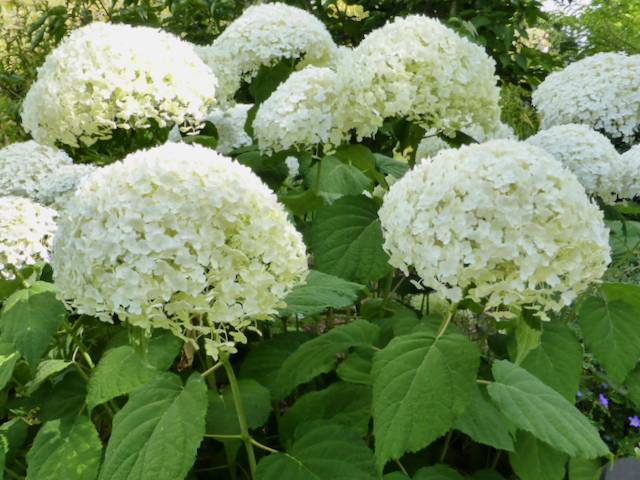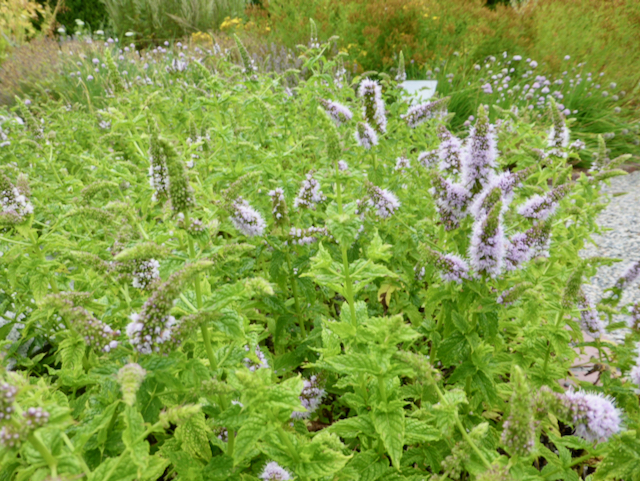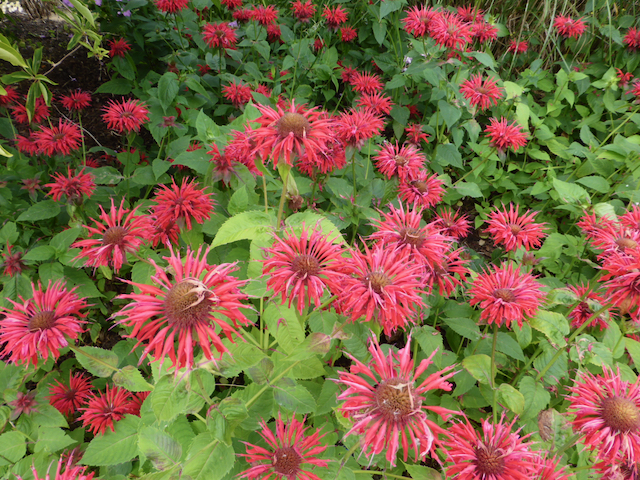August 24-31
Dahlia variabilis (dahlia)
All forty or so species of Dahlia are native to Mexico, Central America or northern South America, but we seldom see the wild species in gardens. Rather, we see hybrid dahlias—most of them derived from a small number of species that were originally exported to Europe starting in the 17th century. Dahlias are like hostas, daylilies or roses in the way they attract a cult-like following of committed horticultural enthusiasts. Dahlia hybrids are exceptionally showy and almost infinitely variable. Plants range from miniatures less than 30 cm tall to giants over 2 m in height. There are button-like flowers no more than 5 cm in diameter, and dinner-plate-sized flowers 30 cm across. Flower colour includes all colours except blue, and while bicoloured and multicoloured flowers are the norm, there are also less flamboyantly-coloured cultivars for those who prefer some chromatic restraint in the garden.
Perhaps the most attractive characteristic of the dahlia is its long season of bloom, which for the majority of cultivars extends through summer until frost. As a rule, dahlias don’t really start growing until soil temperatures warm up to about 15 C°, so August is really the high point in the bloom cycle in Vancouver. Growing dahlias require some commitment to their care, as the more valuable ones demand lifting and storing in the autumn (the tubers do not tolerate frost or our wet winter soils). This is also the main vehicle for dahlia propagation—the lifted tubers can be separated and traded, sold or given away. Dahlias are also easily bred to make new kinds, either intentionally, by moving pollen from one flower to the flowers of a different dahlia, or without the intervention of the gardener, by itinerant beetles, which are the natural pollinators. This is one of the reasons there are more than fifty thousand registered cultivars (yes, fifty thousand).
In general, plants are robust, with multiple leafy stems arising from the underground tubers. The leaves are composed of multiple leaflets and the flowers are produced toward the tips of the stems. Flowers (technically flower heads) are either “single” (i.e., daisy like), with a row of flattened ray flowers surrounding a button of disc flowers, or they are “double flowers,” where the centre of the flower head is populated with ray flowers.
In Dahlia classification, the shape and curvature of the rays and the overall shape of the flower head determines which group a particular dahlia belongs. For example, the popular “cactus dahlia” has ray flowers that are revolute (rolled backwards), while the “anemone-flowered” and “ball dahlias” have ray flowers that are involute (rolled inwards). The genus is named for the Swedish botanist Anders Dahl (1751-1789), who was a student of Linnaeus. Dahlia variabilis is a horticultural name (i.e., not botanically valid) given to Dahlia hybrids for which the parentage is not known.
Hylotelephium spectabile (showy stonecrop)
For many years, this common, late-summer-flowering herbaceous perennial was known as Sedum spectabile. The sedums are a large group of succulent-leaved plants found primarily around the northern Hemisphere, as well is in the Andes Mountains and in higher elevation parts of east Africa, but in the 1970s botanists recognized that although they are related, Hylotelephium and its closest relatives actually form an independent Eurasian lineage separate from Sedum.
Hylotelephium (pronounced: high-low-tell-eff-ee-um) are distinctive plants, with annual stems that arise from a fibrous, tuberous or rhizomatous base (rhizomes are horizontal underground stems). The above-ground stems are not quite pencil-thick and always somewhat woody at the base, which gives the genus part of its name (Greek: hylo = woody). The other part of the name comes from the resemblance to Telephium (tele = distant + phium = love), a European herb that was supposed to represent reciprocated love.
Matters of the heart aside, H. spectabile is native to China and Korea, where it grows on rocky ledges. In the garden, plants form dense, rounded clumps of multiple, upright stems, 30 to 70 cm long. The chubby, oblong leaves are dull blue-green to yellow-green, 3 to 10 cm long and either oppositely arranged or borne in whorls of three up the stem. Each stem is terminated by a broad, showy flat-topped cluster of small, five-petalled flowers, which change in colour from near white in bud to brilliant, rosy pink or purplish-red when open, and then to dull brown when forming seed (spectabile = showy). ‘Brilliant’ is a common cultivar with carmine-pink flowers. Also common is ‘Herbstfreude’ (autumn joy), which is a hybrid of H. spectabile and H. telephium. Hylotelephium telephium (orpine) is native from Europe to Japan and is known for a number of purple-green-leaved mauve-pink-flowered cultivars such as ‘Matrona’. ‘Herbstfreude’ has alternately-arranged leaves (like H. telephium) and salmon pink flowers that open two weeks later than those of H. spectabile.
Malus domestica (orchard apple)
I’m old enough to remember places in Vancouver where the remnants of orchards belonging to old farmsteads still existed. When I was very young, my brothers and I, along with a small coterie of neighbourhood urchins, roamed the back alleys in late summer looking for apple trees from which we could pilfer a few tasty fruits. In our disobedient haste, we mostly plucked them not nearly ripe enough to be worth the effort. The lesson is that many apples can look wonderful in August, but most are not ready to eat until September or later.
Apples are members of the rose family, in the group characterized by fleshy “accessory fruits” known as pomes. This group includes pears, mountain ashes, quinces, hawthorns and a number of other lesser known fruits such as loquats and cotoneasters. All have alternately-arranged, toothed leaves and five-petaled flowers. There are somewhere between thirty and fifty-five species of Malus, all of them deciduous trees or shrubs, native to the North Temperate Zone, with the centre of diversity in Asia. The apples are well known in horticulture, both for the orchard apple—of which there are a staggering seven thousand five hundred (7500) known cultivars—and the crabapples (or crabs), whose foliage, flowers and fruits are often remarkably ornamental. Among Malus species, only M. domestica and its progenitor, the Asian wild apple, M. sieversii from southern Kazakhstan, have notably large fruits, evolved to attract sizable mammals, such as horses or camels, to disperse their seeds. The crabs, which include essentially all other Malus species, have more diminutive fruits that are attractive to smaller animals, particularly birds.
Apple and crabapple flowers are usually pink in bud, opening white, the petals detaching after pollination. The characteristic pome forms from the fertilized ovary, which fuses with the floral tissues (the base of the sepals, petals, stamens and the tip of the flower stalk) that surround it. The star shaped structure enclosing the seeds that is visible when cutting through an apple transversely, is the ovary. Orchard apples are grown for their fruit, either for eating fresh, dried, or after storage, or processed for cider or juice, and apple cultivars are often suited to one or more of those specific purposes. Other than with espaliers (fence-trained tree fruits), production-grown apple trees do not have much aesthetic appeal beyond the flowers and fruit—clearly, aesthetics is not the point of growing them—but unpruned apple trees often have an ornamental, albeit wild quality, particularly after many years of neglect.
Origanum vulgare (oregano, wild marjoram)
Most people are more familiar with oregano as a pizza spice or an awful-tasting common-cold-supressing oil than as an actual garden plant. This is too bad, as oregano is not just renowned for its culinary and medicinal uses, but has considerable ornamental value, as well. Native to western Europe, the Mediterranean region and southern and southwestern Asia, O. vulgare inhabits stony, open sites and grows 20 to 80 cm tall with neat, spade-shaped leaves and open, terminal inflorescences consisting of numerous showy clusters of tiny, white to mauve-pink flowers in summer. Like other mint relatives, the leaves are oppositely-arranged and the nectar-filled flowers are two-lipped and pollinated by bees.
Although small, the flowers of O. vulgare and their accessory structures are worth a closer look. At the base of each flower is a persistent calyx (the sepals are fused together and form a tiny tubular calyx), but there is also a small, persistent leafy bract below the calyx. Because both the bracts and calyces are purple, they are highly conspicuous (often more conspicuous than the open flowers). This is why flower colour is often described as purple. The most commonly cultivated oreganos in gardens (besides the culinary types) are the cultivars ‘Aureum’ (with mauve flowers), and ‘Thumble’s Variety’ (with white flowers), both of which have golden yellow leaves. They are exceptionally handsome cultivars, but all oreganos are short-lived in typical garden conditions. Self-sown seedlings are common, especially where multiple cultivars are grown, and they are usually green-leaved throw-backs—more like the typical wild version of the species—and these will often survive in the cracks in walls and sidewalks where they benefit from the fast drainage and abundant calcium provided by deteriorating mortar or concrete.
Solanum lycopersicum (syn. Lycopersicon esculentum) (tomato)
Tomatoes are originally native to northwestern South America, in what is now either Peru or Ecuador. As the species is naturally weedy in frost-free climates, it eventually spread north into Central America and Mexico. This is where the tomato was domesticated, and where Europeans first encountered them. The earliest tomatoes found their way to Italy in 1544. They were named pomodoro (transl. “golden apples”) as the first seeds produced plants with yellow-skinned fruits. In Europe, tomatoes were initially thought to be poisonous. They are indeed poisonous when unripe, but the fruits of a number of European Solanum relatives, such as Atropa belladonna (deadly nightshade) and Solanum dulcamara (European bittersweet) are highly toxic—even deadly—when fully ripe, so it wasn’t surprising that people would be cautious with this new introduction. Clearly, though, the tomato caught on in Europe as an edible fruit in a big way. It would be hard to think of Italian cuisine without tomatoes! The variety of tomato cultivars available to gardeners today is simply staggering, and they come in a range of colours, sizes and shapes. Red is the most popular colour, but yellow-, streaky- and black-skinned tomatoes are popular, too. I would not be without yellow tomatoes in my community garden plot, as opportunistic thieves appear less likely to recognize a non-red fruit as a ripe one.
Solanum lycopersicum is an annual plant. In hot climates or in greenhouses with winter lighting, tomatoes are considered short-lived perennials. Tomatoes generally bear their flowers and fruits on lateral branches toward the stem tips. In nature, all tomatoes produce indeterminate growth, where stems continue to grow and new flowering laterals continue to be produced until adverse conditions initiate the breakdown of tissues. Breeding work in the last century, however, introduced genes that could cause tomatoes to produce only determinate growth. In this case, all stems would grow to a point and then stop, allowing the plant’s energy to be directed to the developing fruit rather than to producing more leaves and flowers.
Determinate plants are bushy and short branched, and the tomatoes more or less ripen all at once. This is the “field tomato,” which is mostly a machine-harvested field-crop plant. In contrast, indeterminate tomatoes have stems that are mostly long and stringy, and bear fruit over a longer period. Most greenhouse tomatoes are indeterminate types; they are trained on strings that hang from the rafters. As the plants grow, the strings are gradually let out so that the fruiting branches near the tip of the plant are always at the same height (the base of the plant looks like a loosely coiled green rope after a few months). Tomatoes can self-pollinate, but generally require “buzz pollination” to effectively move pollen out of the anthers and on to the appropriate female part of the flower. Buzz pollination is carried out by bumblebees and other solitary bees, not by honeybees.
August 17-23
Canna x generalis (hybrid canna)
Cannas are a group of leafy herbaceous perennials from subtropical and tropical America that spread to form dense colonies from thick, succulent rhizomes (horizontal underground stems). Canna x generalis is a hybrid of C. indica and C. glauca, both widespread species native from Mexico and the Caribbean south to Argentina. Canna glauca is also native to the southeastern US.
There is huge variation in hybrid cannas in both leaf and flower colour. Leaves are broadly oval with pointed tips, up to 75 cm long, arising from petioles (leaf stems) that tightly clasp the sturdy stems. The typical leaf and stem colour are a beautiful, rich green, but variegated-leaf forms (with close-set, alternating yellow and green stripes), and bronze-leaf and red-edged-leaf forms are all common. Flowers, which may be white, yellow, orange, red or pink, are borne in spikes near the tips of the stems. Each flower, which may be 10 cm across, is comprised of three brightly coloured sepals, three larger, similarly-coloured but usually yellow-streaked petals, and often with one or more similarly-coloured staminodes (petaloid sterile stamens) at the centre.
Cannas are unusual for having irregular flowers; that is, the flowers lack symmetry. Despite that, hummingbirds and butterflies are strongly attracted to the flowers. Each flower has a narrow, rigid, pointed bract at the base, often obscured by the petals. However, the bracts are conspicuous before the flowers emerge, overlapping and forming a spiky, club-shaped structure that envelops and protects the expanding flower buds.
The seeds of cannas are produced in warty, three-lobed 2-cm-wide capsules that turn brown and papery once the ball-bearing-like seeds are mature. In some cultures, these seeds are used for rosary beads, in others, for pea-shooter ammunition (don’t tell the kids). In some hybrid canna selections, stems can exceed 2 m in height, but most modern cultivars have been bred to produce flowers on stems less than 1 m tall. Cannas are often treated as bedding subjects, usually surrounded by shorter, equally vivid-flowered bedding plants. The scene can appear somewhat audacious and flamboyant, and I suppose this is what some people are going for.
Cannas are naturally colonizing plants that look at home in extensive colonies, especially close to water. The rhizomes are treated like dahlia tubers; that is, they are only planted when the soil is already warm in early summer. They are lifted and stored in dry peatmoss at the end of the season, usually after the first frost in autumn.
Helianthus annuus (annual sunflower)
Of the seventy or so different species of sunflower, only H. annuus, with its massive flower heads and tall, sturdy, Jack-in-the-beanstalk stems, is familiar to most people. The annual sunflower is native to the American southwest and Mexico and is cultivated commercially for its edible seeds, oil, and, to a lesser extent, for honey. Annual sunflower is also widely used as a phytoremediation species (a plant that extracts, stabilizes or degrades contaminants in soil). As an ornamental in gardens, it is usually grown for its impressive growth rate and often jaw-dropping size, rather than for its bounty of seeds, which are frequently sacrificed to the legions of small, seed-eating birds that swarm the ripening seed heads.
Stems can be branched or unbranched, and every stem generally produces a flower head at its tip. A single-stemmed, unbranched individual can regularly reach 5 m tall with the diameter of a small tree trunk, and the flower head can be 40 cm or more across, whereas a multi-branched individual will be shorter with more numerous, but smaller heads. The flower head may be composed of several hundred individual flowers. The outer, sterile, “ray” flowers are typically bright, golden yellow (to attract pollinators) and the fertile, central, “disc” flowers brown, radiating in subtle spirals from the centre of the head.
When young, well before opening, the flower buds are heliotropic, i.e., they follow the track of the sun through the day. But once they are mature and ready to open, they align themselves to face the morning sun (east in the Northern Hemisphere). The sunflower is thus a reliable compass—if a person is in need of directions in the garden.
Hydrangea paniculata (panicle hydrangea)
Hydrangea paniculata (panicle hydrangea) is a large deciduous shrub or small tree to 6 or 7 m tall, native to China, Taiwan, Japan and Sakhalin (an island of Russia). Among cultivated hydrangeas, it is mostly distinguished by its conical, summer-borne, branched inflorescences (flower clusters), known as panicles. These can be upwards of 25 or 30 cm long and are produced at the tips of the branches. The typical hydrangea panicle is comprised of hundreds of tiny, greenish-yellow to white fertile flowers, with much larger, white, sterile “flag” flowers that are borne at the margins of the secondary branches. The showy sterile flowers are an adaptation to attracting pollinators to the nearly insignificant nectar-rich fertile flowers. When the flowers are ripe, the inflorescences are crowded with bees. In some cultivars, such as ‘Grandiflora’ (pee-gee hydrangea), the fertile flowers are completely hidden by the much more numerous sterile ones.
In general, the sterile flowers of H. paniculata emerge green and become pure white, before burnishing pink in late summer. The papery leaves of H. paniculata are oppositely arranged or commonly three-verticillate (a whorl of three leaves at each node), 5 to 15 cm long by 3 to 8 cm wide. The species can be exceptionally handsome, particularly when allowed to develop naturally, but other than with a few smaller-growing cultivars, it is ultimately a large shrub. Plants are often pruned to reduce their considerable bulk, and this often results in awkward, skeletal-looking branching and fewer, bigger, usually out-of-scale blooms that droop awkwardly. A large number of cultivars have been selected (primarily in Europe), most of them showing variation in only floral characteristics, and even in these, there is considerable similarity.
Lythrum salicaria (purple loosestrife)
Lythrum salicaria (purple loosestrife) was once widely promoted for gardens, especially those with moist or even wet soil, because it is an adaptable plant with beautiful, long-lasting pinkish purple blooms that attract hummingbirds and a variety of pollinating insects. Unfortunately, it is also an extremely aggressive invader of marginal habitats, such as along lakeshores, wetlands, ponds, wet pastures, and roadside ditches. Purple loosestrife spreads prolifically both by seed and vegetatively, by its ropey, white rhizomes. As a result, it has become a common weed in wet places around Vancouver and a major threat to wetlands across North America. Dense, impenetrable stands grow to 2.5 m tall in both natural and disturbed areas, out-competing and replacing native species and impacting animal and bird habitat. Three exotic biocontrol agents (a root-eating beetle and two leaf beetles) have been released in British Columbia and elsewhere in North America to control the spread of purple loosestrife, and these insects are probably responsible for fluctuations in the population locally.
Purple loosestrife is sometimes confused with fireweed (Chamerion angustifolium), as they are both tall, weedy plants with long, narrow leaves (angustifolium means “narrow leaf” and salicaria means “willow-like”). Both species flower at the same time with pinkish-purple blooms, but the two are easily differentiated. Lythrum has four-sided, strongly erect stems with opposite leaves, while Chamerion has curved stems that are round in cross section with alternately-arranged leaves. Purple loosestrife flowers are small with crinkled petals, and they are attractively crowded together in long, slender inflorescences, while fireweed flowers have broad, showy petals and are held in loose, conical clusters.
The name loosestrife—to “loose strife” or get rid of illness—refers to the plant’s historic use as an astringent (drying) medicinal herb.
Magnolia grandiflora (southern magnolia)
Few magnolias elicit as strong a response in people as does this species. Southern magnolia is a popular tree wherever it can be grown, celebrated for its large, lustrous, evergreen leaves, strong growth and especially its beautiful, intensely citronella-scented flowers. It is exceptional for its ability to survive in hot, windy and droughty sites. In the US Deep South, where it is native and in areas with similar climates, southern magnolia can grow to 25 m or more in height, with a dense, rounded crown.
The elliptic leaves are about 30 cm long, usually with short, fine coppery hairs on the undersides. The upper surface is highly reflective and usually somewhat convex. Variation in flowers is not significant between seedlings or most cultivars—the majority of plants produce bowl-shaped flowers about 15 to 20 cm across that consist of between six and twelve creamy white tepals (there is no differentiation between sepals and petals in magnolias, hence, tepals) and a large, conical structure at the flower’s centre, upon which are found the stamens and carpels (pollen and ovule-bearing parts, respectively). Once seeds are formed and the tepals and stamens have fallen away, this attractive cone-like fruit stands above the foliage. As it ripens, the carpels split open and the red seeds are exposed.
August 10-16
Albizia julibrissin (albizia, silk tree, mimosa)
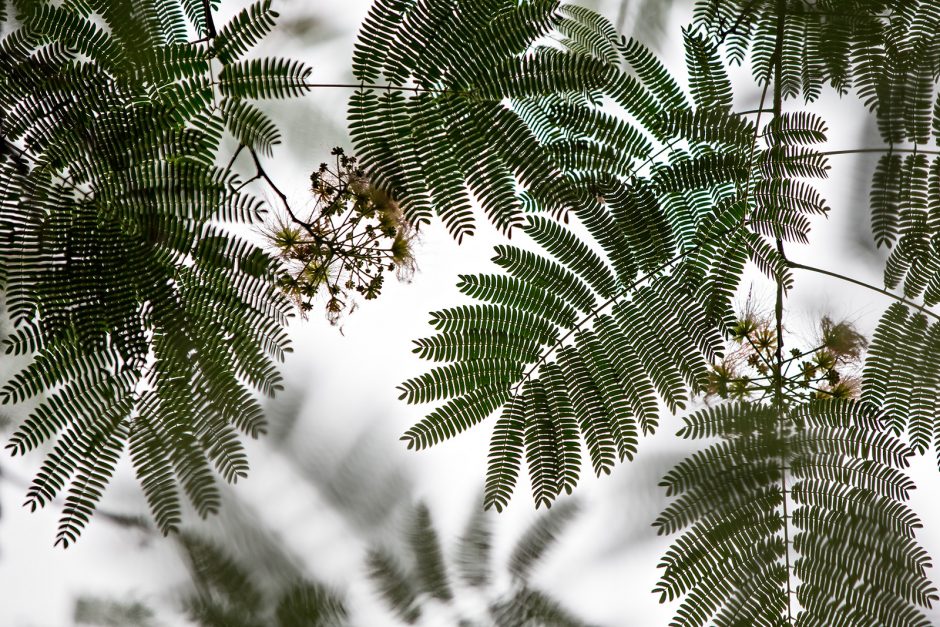
Albizia julibrissin. Photo from Vancouver Trees app.
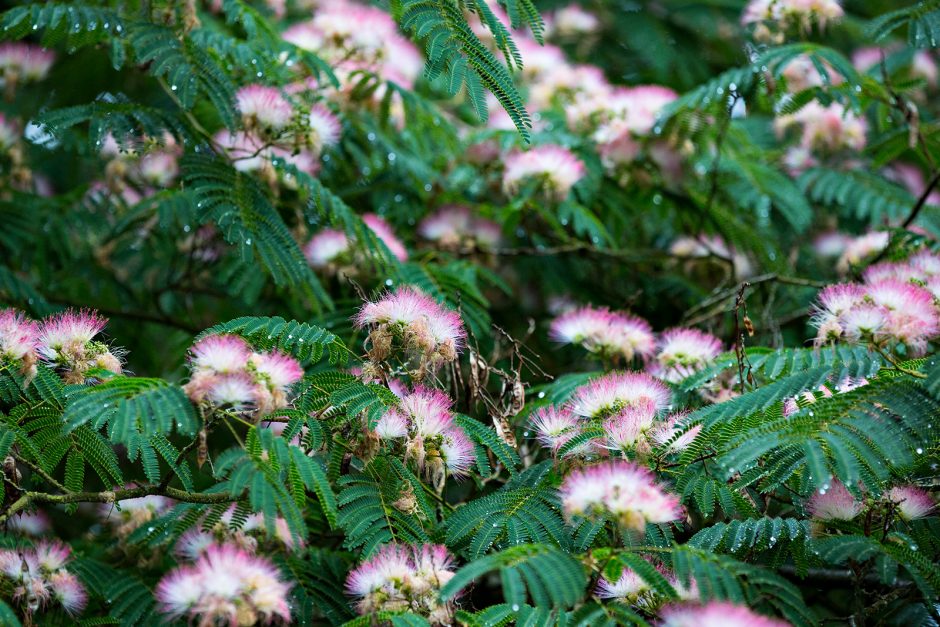
Albizia julibrissin. Photo from Vancouver Trees app.
Albizia julibrissin (albizia, silk tree, mimosa) is an exotic looking, fine-textured tree that is native across southern Asia, from Turkey and the Caucasus in the west through the Himalayas and China, south to Japan and Indochina. Its primary value is in its summer effect: broadly spreading, slender branches produce delicate, finely dissected (twice-pinnately-compound) leaves and silky, pink, powder-puff clusters of late-summer flowers.
During the growing season, the look is graceful, umbrella-like, and very tropical. In the evening, or during cold weather or rain, the leaves neatly put themselves to bed, folding up elegantly until better conditions return. This phenomenon, sometimes known as “night closure” is facilitated by leaf structures called “pulvini,” which are joint-like thickenings that occur along the leaf stems. Pulvini are common throughout the pea family and the most famous example is the tropical Mimosa pudica (sensitive plant), whose leaflets fold up at the slightest vibration.
In the winter, with its few, mostly unbranched stems, the silk tree is conspicuously gaunt. Vancouverites won’t see leaves emerge on a silk tree until the last week of May or first week of June, some six to eight weeks later than most other common deciduous trees. The name Albizia honours the Italian naturalist and nobleman Filippo degli Albizzi who first introduced A. julibrissin to Europe. The specific epithet julibrissin is an alteration of the Persian gul-i abrisham, which means silk flower.
Hibiscus syriacus (rose of Sharon, rose mallow, Korean hibiscus)
Hibiscus syriacus (rose of Sharon, rose mallow, Korean hibiscus) is a small deciduous tree, or more commonly a large shrub, originally native to southern China and Taiwan where it grows along sea cliffs, on stream banks and hillsides, and on other well-drained sites. Because of its great beauty, variability and adaptability, the species has always been highly valued, and historically, it was moved around temperate Asia via common trade routes. Hence, H. syriacus is the national flower of Korea, having been cultivated there for millennia. Its mobility also explains Linnaeus’s mistake in 1753 in naming the plant—the specific epithet, syriacus, suggests the species is native to the Middle East—as well as its seemingly illogical, biblical common name “Rose of Sharon.”
The species grows 1.5 to 4 m tall, the crown developing from a series of strongly upright, sparsely branched shoots arising low on the stem, or directly at ground level. Older wood exhibits silvery-brown bark, with branches standing out from the surrounding landscape as reflective, strongly vertical elements. The papery leaves are variable, nearly always somewhat palmately three-lobed, with three prominent veins, and coarsely toothed.
The flowers are produced near the tips of the current season’s growth in late summer, potentially from the end of July until October. Like many other mallow family plants, the flowers of H. syriacus are trumpet-shaped with a staminal column at the flower’s centre (see the description of Lavatera x clemsonii, in the July 27- August 2 blog). The flowers range in colour from white through pink, red and rose to lavender, mauve and nearly blue, usually with a contrasting red flash at the base of the petals, and they range in size from 5 to 10 cm across. Fertilized flowers develop into 4- to 5-cm-, five-valved capsular fruits that stand upright in the upper branches over the winter.
Salvia guaranitica (anise-scented sage)
Although exceptionally rare in gardens until relatively recently, S. guaranitica is now an increasingly familiar summer-blooming perennial around Vancouver. The species hails from the Highlands of South America and is distinctive in a number of ways (not least that it survives winters here). Despite the common name, the aroma of the bruised leaves and stems is to my nose, at least, as much sagebrush as anise. The fragrance is an interesting combination, but rather pungent and not everybody’s cup of tea.
The stems are tall and willowy and the textured, roughly triangular leaves are a pleasing pale, fresh green. The blue to purple flowers are narrow, with gaping, jaw-like lips. Like other salvias, the flowers have a corolla (the collective term for the petals) that is tubular, but two-lipped beyond the throat. The upper lip forms a cover for the stamens and style (the male and female reproductive parts), and the lower lip provides a landing area for pollinators. The corolla emerges from a persistent tubular calyx (the collective term for the sepals), which in S. guaranitica is green to darkest purple.
The flowers are wildly attractive to hummingbirds (and to me), but bees are also common visitors. They emerge in succession, the flower spikes growing ever taller as the season progresses. Several cultivars are available, including the robust and aptly named ‘Black and Blue’, which is probably the most popular. ‘Black and Blue’ grows 1.5 to 2 m tall and has particularly dark (nearly black) calyces that contrast effectively with the indigo-blue flowers. ‘Amistad’ with violet-purple corollas and dark purple calyces is a S. guaranitica x S. gesneriiflora hybrid, and somewhat less robust growing in Vancouver. The name guaranitica means “of the Guarani,” probably referring to the area that spans Paraguay, northwestern Argentina, eastern Bolivia and southwestern Brazil and that is inhabited by a group of culturally-related indigenous peoples known as the Guarani.
Tagetes erecta (African marigold)
The always quotable herbaceous plant expert, Allan M. Armitage, writes that “…in the language of flowers, marigolds mean sorrow and despair; in Mexico, they are called la flor de la muerte (“the flower of death”). Here [in America], they are simply referred to as bedding plants.” However you feel about them, they are among the hardest working annuals we grow in our gardens. Flowering from early June until frost, few plants can keep up with their floral prowess.
There are some fifty species of marigolds, but the vast majority are virtually unknown to the average gardener. In North America, the two most popular species are T. erecta (African marigold) and T. patula (French marigold). Despite geographical names to the contrary, all Tagetes species are native to the Americas (North and South), and both of the aforementioned species are native to southern Mexico. Tagetes erecta is also known by the somewhat anthropologically accurate “Aztec marigold” and “Mexican marigold” is also given, but then, nearly all of the cultivated species are Mexican.
The species grows 60 to 120 cm tall, although dwarf forms are very common, many barely exceeding 20 cm in height. There’s something festive and exuberant about the taller selections of this marigold. Leaves are dark green and pinnately divided (like a fern frond) with eleven to seventeen narrow, well-toothed divisions. The stems, flowers and leaves all have a distinctive fragrance—it’s not everyone’s favourite, but for me it often conjures up memories of carefree hot summer days and big displays of bedding plants in public parks when I was a youngster. Stems are angular and often brittle, especially with the large pompom flowers of the most common cultivars. The flower heads are 5 to 10 cm across, typically bright yellow or yellow-orange. As I’ve described previously in this blog series, members of the sunflower family are characterized by their composite flowers (many small flowers clustered together in a condensed head and appearing as a large single flower). Daisy-like flowers, such as coneflowers, black-eyed-Susans, sunflowers and Shasta daisies all have a central disc of tiny short-petalled flowers surrounded by a ring of flowers that have a tongue-like petal that radiates away from the centre of the flower head (these are known as “ray florets,” while the inner flowers are known as “disc florets”). Marigolds also follow the same general pattern, with both disc and ray florets. However, practically all cultivated marigolds are “double-flowered”; that is, in these plants nearly all of the flowers in the head are ray florets with broad petals.
Verbena bonariensis (purple-top or tall verbena)
Native to Uruguay, Chile and Argentina (bonariensis means “from Buenos Aires, Argentina’), V. bonariensis is a perennial herb with stiffly erect, four-angled stems to more than 2 m tall. The impossibly slender stems are rough to the touch and bear few branches, except near the tips. These and the main stem are terminated by broad, flattened clusters of delightfully small, tubular, violet-purple flowers. Plants flower almost continuously from mid-July until frost and are mobbed by bees, butterflies and hummingbirds for the nectar-filled flowers.
Like the stems, the leaves are covered in scabrid hairs (they feel like shark skin). They are long and narrow, longest toward the base, but barely noticeable among the close stands of the green, photosynthetic stems. Not so many years ago, experts would tell novice gardeners that V. bonariensis was a bad bet because it would not be expected to survive a typical Vancouver winter. Nowadays, purple-top verbena is widely grown in local areas. It is fair to ask whether this success is a result of a warming climate, or due to more intelligent siting in general. There’s another aspect to this question: how will V. bonariensis behave if the climate continues to warm? Purple-top verbena is on the invasive species watchlist for Washington state, and is seriously invasive in many subtropical regions of the world. For the moment, V. bonariensis is not particularly worrisome, since our winters are typically cold and wet and these conditions effectively kill off seeds that are lying around. It is a valuable late-summer pollinator plant, and a lovely species that adds elegance and a gentle, swaying movement to plantings.
August 3-9
Acanthus hungaricus (Balkan bear’s breeches)
One of the abiding mysteries of horticulture is the origin of the common name “bear’s breeches.” What part of the plant looks like the trousers (breeches) worn by a bear? Anyway, it’s difficult to argue with a name that has been in use for four hundred years. While its original meaning may be lost, I suspect its sustained popularity has much to do with it being both non-sensical and evocative. The genus Acanthus consists of around twenty-five species of perennials, shrubs and small trees from southern Europe, Africa, western, southern and eastern Asia and Australia, but only two or three herbaceous species are cultivated locally. The most common of these is A. hungaricus (which is sometimes sold as A. balanicus, and often misidentified as A. spinosus), which comes from the Balkans, and is among the cold-hardiest and most resilient of the cultivated species. The leaves are dark green and up to 90 cm long by 25 cm wide, but they are deeply and broadly dissected, the lobes narrowed to spiny-looking points (though they are not particularly sharp). Without flowers, the plants typically look like a jumbled mass of foliage.
The flowers, however are definitely the main event. Once the flower stalks are fully extended—rising to 1.5 m or more—they dominate the scene. Individual flowers are comprised of an expanded maroon calyx (the calyx is the collective term for the sepals) that sandwiches a white corolla (the corolla is the collective term for the petals) that is tubular at its base and has three broad lobes derived from the lower petal (all other petal tissues are absent beyond the basal tube). Below each flower on the stem is a stiff, exceptionally spiny bract, and the sharp spines on the bracts are what you will encounter when investigating the flowers. This is potentially very painful. Not so for the bee. Inside the flower are stout, curved, spring-loaded stamens, and pollinating bees only have to push in between the stamens and the lower petal lip to reach the nectar reward. You can take my word for it.
Hydrangea arborescens (American hydrangea)
Hydrangea arborescens (American hydrangea) is primarily an Appalachian species, native to much of the eastern US. The species grows with multiple, sparsely-branched, sprawling to upright stems up to 2 or 3 m tall, but plants are usually about half that height in cultivation. The leaves are oval to broadly oval, 5 to 15 cm long, with regular, large, coarse serrations along the margins. The leaves are borne on long, slender petioles (leaf stems) and are thin and somewhat flimsy for their size compared with most Asian Hydrangea species. Flowers are produced at the tips of the current season’s growth, usually in July and August. In the wild, the inflorescences (flower clusters) are generally flattened, 5 to 20 cm across and composed of tiny fertile flowers surrounded by a ring of showy, sterile flowers. The inflorescences of cultivated plants are more of a globular, “mop-head” type, consisting of mostly large sterile flowers. A number of popular cultivars produce oversized, heavy, globular inflorescences that can cause stems to flop on the ground, which looks attractive if plants are given adequate room.
The following two cultivars are common: ‘Annabelle’ is an old cultivar that produces heads of sterile flowers some 20 to 30 cm across on weak, ultimately drooping, 1.25 m stems. Once the standard for oversized inflorescences, ‘Annabelle’ has been mostly superseded by newer, sturdier-stemmed cultivars, such as the popular ‘Abetwo’, which has the marketing name Incrediball®. ‘Abetwo’ is a tough, 1.25-m-tall plant that produces ridiculously large, nearly spheroid inflorescences up to 30 cm across that are packed with sterile flowers. They are lime green when expanding, and then white.
Mentha spicata (spearmint)
The mints are both loved and maligned as garden plants. They have been cultivated for millennia for their medicinal, culinary and aromatic qualities. Merely brushing by a plant sends its fragrance aloft and the smell of mint is almost universally loved. However, left alone in a garden bed, almost any species of mint will run. And even mints in containers are best monitored with a keen eye, as their rhizomes (horizontal underground stems) can emerge from a hole in the bottom of a pot as easily as they can stealthily creep over a rim and invade an adjacent container, or descend to the ground to make merry in the soil.
Mentha spicata is one of the most widely grown of the two dozen or species in this Eurasian, African and North American genus of aromatic perennial and annual herbs. Spearmint is native to Eurasia and is thought to have been brought to North America with the earliest European settlers. It is widely cultivated across the temperate world. Mints are known to repel rodents and spearmint oil is an effective ant repellent. The species is readily recognized by its strong, tangy, lemon-mint fragrance, but also its stalkless, pointed, narrow, jagged-edged, rugose (wrinkled) leaves. The lowest leaves on the stem can be nearly 10 cm long, while those near the tip are generally no more than half that size. Like other mints, each pair of leaves is borne at 90 degrees to pair below it. Stems are smooth, stiff and straight, 30 to 90 cm tall, with regular branches arising initially at about 30 degrees from the horizontal. In summer, plants produce tiny pinkish flowers in congested conical spikes at the tips of the stems. The nectar-filled flowers are adored by honeybees.
Monarda didyma (bee balm, Oswego tea)
Speaking of bees, the flowers of this eastern North American native plant are renowned for their ability to attract bees (a balm is salve or lotion, but it can also be a cheer or comfort). Bees are definitely seduced by the nectar-filled flowers. There are sixteen Monarda species, all from North America and Mexico, and immediately recognizable by their curious globular flower clusters situated at the tips of square stems. The leaves and stems are all pleasantly aromatic and have traditionally been used for tea by Oswego Native Americans. The common name Oswego tea derives from the Iroquoian word osh-we-geh (the river’s mouth) which gave its name to the river and place in upstate New York as well as the peoples who originally lived there.
The most common of the bee balms in gardens is the scarlet-flowered M. didyma, but the smaller and less spectacular M. fistulosa (wild bergamot) is also grown, and several hybrids, often with white, lavender or pink flowers, are also planted. Both the flower and inflorescence structure are distinctive, but merely variations on those of the typical mint family member. The individual flowers are tubular, claw-like before opening. Then, opening wide, the narrow, hooded upper lip remains stiff while the lower lip declines floppily. Like in other mints, the flowers have short stalks and the clusters are paired on opposite sides of the stem; however, there are so many flowers in each cluster that they merge together into a single whorl. At the base of each whorl is a set of leaf bracts that are often suffused with the colour of the flowers. While bees are common visitors, the flowers are likely more effectively pollinated by hummingbirds, for which the flowers are perfectly adapted.
Phlox paniculata (border phlox)
Phlox paniculata (border phlox) is a common herbaceous perennial and a favourite of cottage gardens, being a summer bloomer and cheerily colourful with fragrant flowers. In the right conditions (full sun with plenty of air circulation), border phlox can be magnificent. It is substantially less so in the wrong environment. When plants are stressed from poor air flow, shade, rain or drought, powdery mildew can be a curse. The disease is all too familiar on P. paniculata in Vancouver, disfiguring and distorting leaves and stems and sometimes flowers with grey powdery spots, then yellowing and worse. Modern hybrids that include P. maculata and or P. carolina (both species with thicker, more resilient leaves) are generally more disease-resistant, but susceptibility varies with the season as much as with particular cultivars.
Border phlox are colony-forming plants and typically strongly upright, usually to 1 or 1.5 m tall. The smooth, long, narrow, leaves are borne in nearly horizontal spreading pairs, each at roughly right angles to the pair below. Flower stalks appear toward the stem tips, each subsidiary branch reaching upwards and contributing to a dense pyramid of pinwheel-shaped white, pink, mauve or purple flowers at the apex. A close look at the flowers shows that the buds have a characteristic twist at the tip. This is technically known as “contorted aestivation”—aestivation is the positional arrangement of flower parts in the bud. And note that each petal in the open flower overlaps the edge of the adjacent petal in the same way, which is the result of this particular aestivation. The flower itself has a small five-lobed calyx and a corolla that has a long tube, but opens flat, providing a platform for (mostly) butterfly pollinators.

